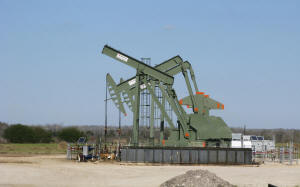Oil prices up after incident involving vessel off Oman coast
 Send a link to a friend
Send a link to a friend
 [November 16, 2022] By
Ahmad Ghaddar [November 16, 2022] By
Ahmad Ghaddar
LONDON (Reuters) -Oil prices rose on
Wednesday, erasing earlier losses, after an incident involving a
commercial vessel off the coast of Oman, but rising COVID-19 cases in
China capped gains.
Brent crude futures gained 65 cents, or 0.7%, to $94.51 a barrel by 0854
GMT, and U.S. West Texas Intermediate (WTI) crude futures rose 35 cents,
or 0.4%, to $87.27 a barrel. Both benchmarks fell more than $1 earlier
in the session.
The United States Navy's Fifth Fleet said it aware of an incident on
Wednesday in the Gulf of Oman involving a commercial vessel, Commander
Timothy Hawkins told Reuters.
The Associated Press had reported that a Liberian-flagged oil tanker
operated by the Singapore-based Eastern Pacific Shipping was struck in
an exploding drone attack off the Gulf of Oman.
Oil prices settled higher on Tuesday after oil supply to parts of Europe
via a section of the Druzhba pipeline was temporarily suspended,
according to oil pipeline operators in Hungary and Slovakia.
The disruption was concurrent with an explosion in eastern Poland near
the Ukraine border that killed two people and raised the possibility
that the Russian-Ukraine conflict could spill over.
But after the initial "knee-jerk rally in oil prices, the tepid market
follow-through reflects the significant prudence that will be taken to
avoid an escalation," said Stephen Innes, managing partner at SPI Asset
Management.
U.S. President Joe Biden's comments that the missile was probably not
fired from Russia also helped to ease immediate escalation worries,
Innes said.

[to top of second column] |

A pump jack stands idle in Dewitt
County, Texas January 13, 2016. REUTERS/Anna Driver/

In China, rising COVID-19 cases weighed on sentiment after an easing
of virus restrictions this week.
"Oil demand growth in the country is being hampered by its
unyielding faith in a zero-tolerance COVID-19 policy and persistent
economic weakness," PVM Oil analyst Stephen Brennock said.
The International Energy Agency (IEA) forecast demand growth to slow
to 1.6 million bpd in 2023 from 2.1 million bpd this year.
Earlier, the Organization of the Petroleum Exporting Countries
(OPEC) cut its forecast for 2022 global oil demand growth for a
fifth time since April, citing mounting economic challenges.

Industry data showing a bigger-than-expected drop in U.S. crude
stockpiles provided some support to oil prices. [API/S]
U.S. crude oil inventories fell by about 5.8 million barrels for the
week ended Nov. 11, market sources said, citing American Petroleum
Institute figures.
By comparison, seven analysts polled by Reuters estimated on average
that crude inventories dropped by about 400,000 barrels.
Official U.S. inventory data from the Energy Information
Administration is due at 10:30 a.m. EST (1530 GMT). [EIA/S]
(Additional reporting by Isabel Kua in Singapore; editing by Barbara
Lewis)
[© 2022 Thomson Reuters. All rights
reserved.]
This material may not be published,
broadcast, rewritten or redistributed.
Thompson Reuters is solely responsible for this content. |